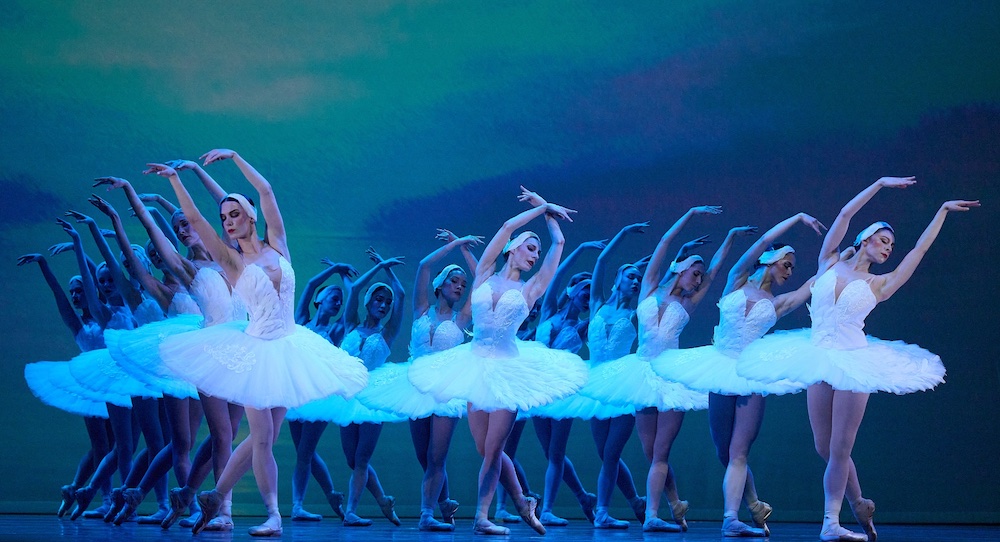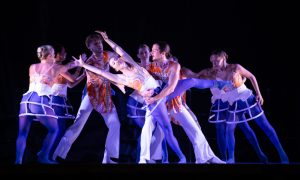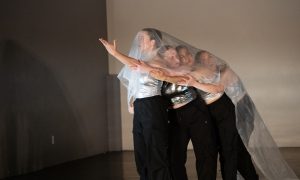Veterans Memorial Auditorium, Providence RI.
May 3, 2025.
In every fairy tale, there is a paradox of peril and majesty that co-exist. Humans encounter otherworldly forces – and from that overwhelming beauty, wonder and power….but also danger. Unicorns blind with their pulsing light, witches poison. Fae delight, but also deceive. Some sort of “happy ever after” comes with learning to meet the majesty and overcome the peril.
Ballet RI‘s staging of the canon classical ballet Swan Lake – by Executive Director Kathleen Breen Combes, Artistic Curator and Resident Choreographer Yury Yanowsky, and Creative Collaborator Anaïs Chalendard – captured this sense of simultaneous wonder and danger. Amidst insightful design, impressive theatricality, and a notable raising of the technical mastery bar for the company, that feeling in the ether prevailed most for me. Thus, I walked away in my own absorbing wonder – but also mental turbulence of thought provoked.
The curtain opened on midnight lighting (by Conor Mulligan), ethereal mystery thick in the air as the White Swan entered. She bourréed with her signature soft port de bras of bird flight and then exited. The stage was set for her to be a prevailing heroine.
Next, under brighter lighting, court figures danced with both strength and effervescence. Royal elegance abounded as we met key characters and the context was set. Soft waltz typified royal stateliness, with white costuming supporting the pristine atmosphere.
Shifting staging and structures of small dance vignettes embodied workings of the court – and perhaps even literal dances when the dealings were done. Even from this early point, the cast’s spritely, yet grounded characterization was clear. Pantomime expressed what needed to be expressed, but stayed out of “hammy” territory.
Particularly memorable was a wispy, yet technically rock-solid trio from Clay Murray, Nina Yoshida-Webster and Heather Nichols. Their musicality had them riding the waves of the score’s notes like virtuoso surfers. Murray offered a commanding, yet eminently accessible presence. Yoshida-Webster lengthened through musical notes and into stage space. Nichols danced with both sweet innocence and mature refinement.
We soon met Prince Siegfried, immediately getting a sense of his yearning – which Brian Gomez built with full clarity and heart. His movement and presence were tender, yet full of passionate conviction. Behind the dancers, through all of this action, hung a backdrop of a cream-white picture frame: imbuing them with a sense of history and high class, as well as literally framing them as central players in the story to come.
Act II brought us into the wild: a moonlit lake, the home of the swans. So much light and wonder pulsated…but also, what potential danger and darkness? Alexandria Troianos, as the White Swan Odette, was as technically impressive as ever. Yet, here she brought her theatricality to a new level, creating a truly striking pathos in the character: eyes averted, epaulement expressing the exhaustion that desolation breeds, crossed wrists wilting just so. She was the beautiful majesty, but also evoked ensnaring emotional peril.
Troianos also filled all of the score in a way that deepened the character’s pathos, the continued ache – apart from creating space for captivating kinetic nuance. In the White Swan’s first interactions with Siegfried, she evoked a compelling coyness. Their dynamic grew rich and entrancing before long.
The Swan Corps, for their part, epitomized classical elegance. The blues and purples in lighting added soft hues to their white tutus. Shadows danced around them and on the white walls stage right and left, long in bright moonlight.
The narrative proceeded through to the exceedingly challenging, and fairly iconic, Swan Corps petit allegro – which they danced with commendable cohesion and musicality. Presenting a satisfying contrast to such tight, lightning-fast petit allegro was a spacious and luxurious duet: two swans dancing together by this moonlit lake.
Yet, all was not peaceful and sweet; the sorcerer Baron Von Rothbart (Styles Dykes) infused menacing darkness. He entered and exited earlier in the act, thus establishing that feeling. He returned toward the end to threaten the connection of Siegfried and the White Swan. The Prince reached towards the audience, bereft, as the curtain dropped for intermission.
Act III brought us back into the palace, the backdrop a gorgeous hall of Gothic columns. The stately court was a rainbow of tastefully bright colors: forest greens, wooden earth tones, mustard yellows, all with just the right level of opulent adornment (costume design by Hailey Corrigan).
Court ladies moved solo, then together – with unified yet wonderfully distinct qualities. These delightful divertissements reflected ambassadors of various cultures come to visit. Red and black costuming, as well as rhythmic touches such as castanets in the score, reflected Spain.
Anastasia-reminiscent costuming, as well as the score’s particular swelling, portrayed Hungary. Audrey Lukacz served as a tenacious, enticing soloist – together with the ensemble offering something vivaciously explosive. “Neapolitan” was sweet and pleasing, eating up space and emanating joy.
Von Rothbart then returned; cycling back into darkness is inevitable. Indeed, we also soon encountered the Black Swan Odile: Troianos, with more superb theatricality, bringing a sly confidence fully contrasting the sweetness and sadness of the White Swan (achieving that contrast is key with this role – and something she very much delivered). This dark counterpart was a beautiful danger all of her own.
While she and Siegfried next danced, the White Swan moved, projected, on the back wall of the court hall: with Swan port de bras and an agitated air, bourreing tightly. The effect was visually captivating, but also highly meaningful metaphor; was the White Swan confined, yet still moving, her spirit threatened yet still resonating and ready to again rise? Beauty was caught in peril.
Siegfried, for his part, was ensnared; soon the Black Swan had him kneeling before her. The White Swan again danced in the backdrop – in a confined, agitated way, yet moving all the same. Her spirit lived, if by a thread.
Act IV brought us back into the wild, to the moonlit lake. The Swan Corps moved with more somber weight than when we had last seen them. The score rang this heaviness through the theater. More lightness began to ring through it, however, while the Swans’ spines started to find more lift. Hope seemed to rise; just as darkness returns, so does light.
The White Swan reappeared, complete with her emotional storm. She melted, succumbing to its pull. Yet she didn’t do so alone; the Swan Corps surrounded her, as if in protection. They moved with a new ferocity and purpose: the White Swan’s defensive force assembled!
Siegfried returned to be part of that force. All together, they stood up to the shadowy threat of Von Rothbart – stood him down, him collapsing. The dark force defeated, Siegfried carried a limp Odette forward towards the audience – towards returning life. Wonder and majesty had overcome danger and darkness.
She came to stand on her own two feet, in the simple dress of a woman rather than the full, soft feathers of a swan. She and Siegfried danced, now man and woman, having overcome the darkness and difference that separated them.
A sunrise slowly spread over the backdrop: a poignant design choice reflecting the hope and light now within reach for the hero and heroine. The Swans continued circling, surrounding in protection and care. Friendship and fellowship also matter in a new day.
These are timeless, universal themes, welcome reminders for souls across time and life station. It was wonderful to experience them from Ballet RI: packaged with design excellence, theatrical command, and a notable advancement in the company’s classical technical prowess.
I felt proud and pleased that the company from my little state’s capital city kept such timelessness – with all of the peril and majesty therein – resonating, and elevated through such superb artistry. The Black Swan’s darkness may creep our way, but we can be the White Swan who escapes its constraints.
By Kathryn Boland of Dance Informa.













